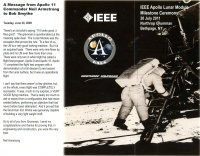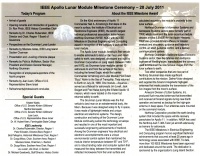Milestone-Nomination:Grumman Lunar Module: Difference between revisions
No edit summary |
No edit summary |
||
| Line 9: | Line 9: | ||
<br>The milestone plaque may be viewed at Northrop Grumman Aerospace Systems, Battle Management and Engagement Systems' Headquarters, Building 25, 600 Grumman Road West, Bethpage, NY 11714, where some of the Grumman Lunar Module engineering was executed. Building 25 is next to the original Grumman building 5 where the Grumman Lunar Module was built and tested. <br> | <br>The milestone plaque may be viewed at Northrop Grumman Aerospace Systems, Battle Management and Engagement Systems' Headquarters, Building 25, 600 Grumman Road West, Bethpage, NY 11714, where some of the Grumman Lunar Module engineering was executed. Building 25 is next to the original Grumman building 5 where the Grumman Lunar Module was built and tested. <br> | ||
[[Image:2010-08 Lunar Module ceremony brochure002.jpg|thumb|right|200px|Ceremony brochure page 2]] | [[Image:2010-08 Lunar Module ceremony brochure002.jpg|thumb|right|200px|Ceremony brochure page 2]] <br>>[[Image:Charles Rubenstein and Pat McMahon unveilling plaque.jpg|thumb|left|Pat McMahon, Senior Vice President and General Manager, Northrop Grumman Aerospace Systems and Charles Rubenstein, IEEE Region I Director, unveiling plaque]] | ||
<br>>[[Image:Charles Rubenstein and Pat McMahon unveilling plaque.jpg|thumb|left|Pat McMahon, Senior Vice President and General Manager, Northrop Grumman Aerospace Systems and Charles Rubenstein, IEEE Region I Director, unveiling plaque]] | |||
<br> | |||
<br>A photograph of the dedication ceremony can be seen at: [http://media.globenewswire.com/noc/mediagallery.html?pkgid=10032 http://media.globenewswire.com/noc/mediagallery.html?pkgid=10032] | <br>A photograph of the dedication ceremony can be seen at: [http://media.globenewswire.com/noc/mediagallery.html?pkgid=10032 http://media.globenewswire.com/noc/mediagallery.html?pkgid=10032] | ||
<div class="header"><span class="head1">INNOVATION</span><span class="head2"> MAP</span></div> | <div class="header"><span class="head1">INNOVATION</span><span class="head2"> MAP</span></div> | ||
Revision as of 16:40, 2 August 2011
Docket Number: 2010-08
Proposal Link: https://ethw.org/Milestone-Proposal:Grumman_Lunar_Module
Grumman Lunar Module, 1962-1972
The Grumman Lunar Module was the first vehicle to land man on an extraterrestrial body, the Moon. Because it was designed to fly solely in space, its design, construction and testing continuously pushed the technology envelope for lightweight metals and unique electrical and electronic systems resulting in one of the most important and successful engineering achievements of mankind.
The milestone plaque may be viewed at Northrop Grumman Aerospace Systems, Battle Management and Engagement Systems' Headquarters, Building 25, 600 Grumman Road West, Bethpage, NY 11714, where some of the Grumman Lunar Module engineering was executed. Building 25 is next to the original Grumman building 5 where the Grumman Lunar Module was built and tested.
>
A photograph of the dedication ceremony can be seen at: http://media.globenewswire.com/noc/mediagallery.html?pkgid=10032
<googlemap version="0.9" lat="40.751609" lon="-73.501845" zoom="10" width="300" height="250" controls="small"> 40.751609, -73.501845, Grumman Lunar Module Northrop Grumman Aerospace, Bethpage, New York, U.S.A. </googlemap>
References
1) Kelly, Thomas J. (2001). Moon Lander: How We Developed the Apollo Lunar Module (Smithsonian History of Aviation and Spaceflight Series). Smithsonian Institution Press. ISBN 1-56098-998-X.
2) Baker, David (1981). The History of Manned Space Flight. Crown Publishers. ISBN 0-517-54377-X
3) Brooks, Courtney J., Grimwood, James M. and Swenson, Loyd S. Jr (1979) Chariots for Apollo: A History of Manned Lunar Spacecraft NASA SP-4205.
4) Sullivan, Scott P. (2004) Virtual LM: A Pictorial Essay of the Engineering and Construction of the Apollo Lunar Module. Apogee Books. ISBN 1-894959-14-0
5) Stoff, Joshua. (2004) Building Moonships: The Grumman Lunar Module. Arcadia Publishing. ISBN 0-7385-3586-9
6) Stengel, Robert F. (1970). Manual Attitude Control of the Lunar Module, J. Spacecraft and Rockets, Vol. 7, No. 8, pp. 941–948.
7) Pullo, Frank ; Salvarezza, Michael, ATTS - ATLAS template translation system, AUTOTESTCON '86; Proceedings of the International Automatic Testing Conference, San Antonio, TX; UNITED STATES; 8-11 Sept. 1986. pp. 211-216. 1986
Please also include references and full citations, and include supporting material in an electronic format (GIF, JPEG, PNG, PDF, DOC) which can be made available on the IEEE History Center’s Web site to historians, scholars, students, and interested members of the public. All supporting materials must be in English, or if not in English, accompanied by an English translation. If you are including images or photographs as part of the supporting material, it is necessary that you list the copyright owner.
Historic significance of this work: its importance to the evolution of electrical and computer engineering and science and its importance to regional/national/international development.
Most people can tell you where they were when the Grumman Lunar Module landed on the moon. In addition to throngs of people crowding highways and beaches near the launch site, millions watched the event on television around the world. This historic and revolutionary engineering project captured the imagination of people all over the world. After winning a contract in 1962, nearly 3,000 Grumman engineers and more than 7,000 people in all created more than a dozen hand-built lunar modules fulfilling President John F. Kennedy's vow to put a man on the lunar surface by the end of the decade. The Apollo 11 space flight landed the first humans on Earth's Moon on July 20, 1969. The mission, carried out by the United States, is considered a major accomplishment in human exploration and represented a victory by the U.S. in the Cold War Space Race with the Soviet Union. Apollo 13 was the third Apollo mission intended to land on the Moon. That mission, launched on April 11, 1970, was aborted as a fault in electrical equipment inside one of the Service Module's oxygen tanks produced an explosion which caused the loss of both tanks' oxygen, depriving the Service Module of electrical power. This forced the crew to shut down the Command Module to conserve its batteries and oxygen needed for the last hours of flight, and use the Grumman Lunar Module's resources during the return trip to Earth. Despite great hardship caused by limited power, loss of cabin heat, shortage of potable water, and the critical need to jury-rig the carbon dioxide removal system, the crew returned safely to Earth on April 17 as a result of the magnificent engineering expertise which built the Grumman Lunar Module.
Features or characteristics set this work apart from similar achievements
The Grumman Lunar Module was the first vehicle to land man on an extraterrestrial body, the Moon.
http://www.ieeeghn.org/wiki/images/5/5a/Grumman_Lunar_Lander_Model-1-.jpg
Because it was designed solely to fly in space, the Grumman Lunar Module was made of lightweight metals and unique electrical and electronic systems. The design, construction and testing of the Grumman Lunar Module continually pushed the technology envelope and resulted in one of the most important and successful engineering achievements of mankind.
http://www.ieeeghn.org/wiki/images/4/4d/Schematic_of_Grumman_Lunar_Lander.jpg
Some of the electrical and electronic accomplishments related to the Grumman Lunar Module included a unique environmental control system that maintained the module interior temperature between 65 and 70F. The Grumman Lunar Module had a robust landing radar and computer system that measured the delay between the transmitted and reflected microwaves from the Lunar surface and calculated accurately the Grumman Lunar Module's proximity to the lunar surface. The Grumman Lunar Module's ascent stage's radar antenna also received transmissions from the Command Surface Module's transponder and calculated the Grumman Lunar Module's precise position and speed during docking. The guidance computer used on the Grumman Lunar Module was the first computer to use Integrated circuits in its design.
http://www.ieeeghn.org/wiki/images/6/67/Grumman_Lunar_Lander_Front_Cabin.jpg
The Grumman Lunar Module had S-band 2-Gigahertz high-gain antennas that made possible the transmission of the live images from the moon's surface. These flush-mounted antennas transmitted and received all S-band signals during near-Earth operation and served as backup for the high-gain antenna in deep space. Four antennas were mounted on the command module. The Grumman Lunar Module program also developed critical software for mission analysis and simulation, guidance and trajectory control, an abort guidance control, and a backup communications system.
http://www.ieeeghn.org/wiki/images/6/63/Grumman_Lunar_Lander_S-Band_Antennas.jpg
The Northrop Grumman Electronic Systems sector, then the defense and electronics business of Westinghouse, manufactured the camera used to broadcast the now famous images from the lunar surface to earth. Initially, the camera was attached to the modular equipment stowage assembly (MESA), which was lowered to a position off to the side of the module’s ladder. After Armstrong and Buzz Aldrin were on the moon’s surface, the camera was placed on a tripod and moved to a location that would capture an overall view of activities. The engineer and the camera itself received television’s prestigious Emmy award.
http://www.ieeeghn.org/wiki/images/3/3f/Grumman_Camera_On_Grumman_Lunar_Lander.jpg
Letter from the site owner giving permission to place IEEE milestone plaque on the property.
The letter is necessary in order to process your nomination form. Click the Attachments tab to upload your letter.
http://www.ieeeghn.org/wiki/index.php/Image:Grumman_Lunar_Lander_Milestone_Support_Letter.PDF
Advocate Approval.doc

